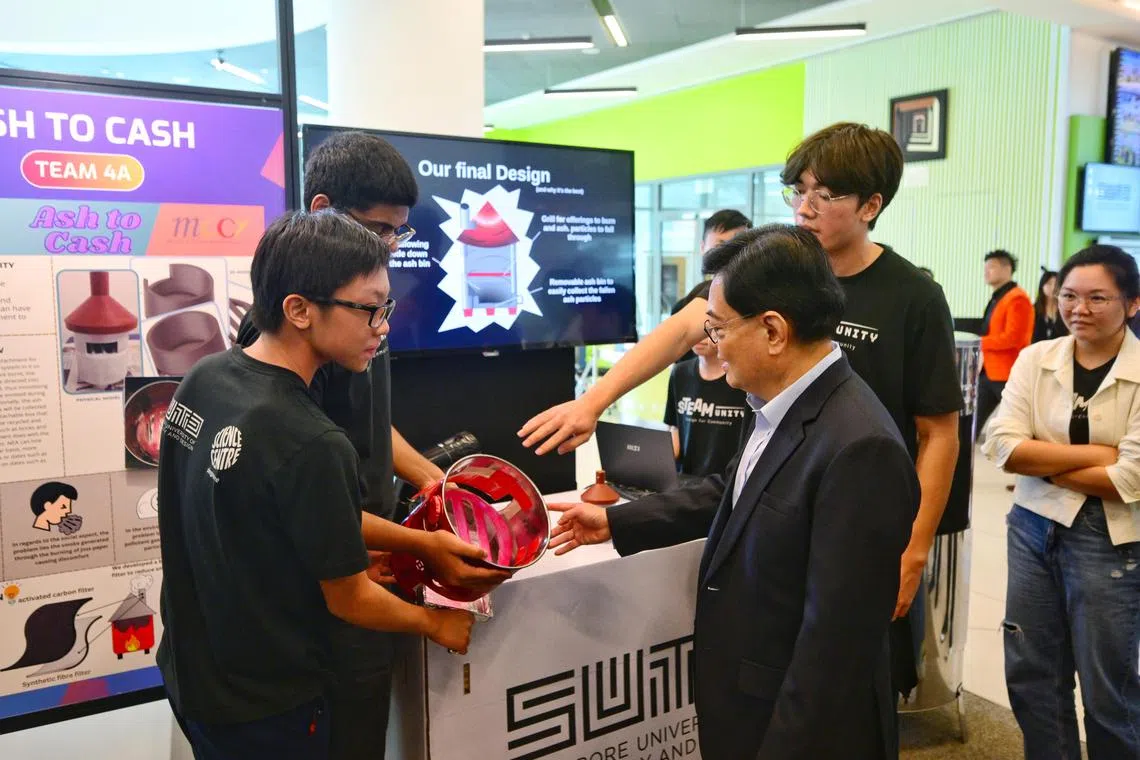Filter-and-collect system for burning of offerings among projects of youth innovation programme
Sign up now: Get ST's newsletters delivered to your inbox

Student Jonathan Liang (right) and teammates showing DPM Heng Swee Keat (third from left) the design of their burner filter system with ash collection box on Sept 9.
ST PHOTO: AZMI ATHNI
Follow topic:
SINGAPORE – A group of teenagers have developed an innovative burner filter system with an ash collection box to address the public safety hazards and environmental impact of burning paper offerings.
Aged 14 to 17, the seven students got together in June to look into concerns about the smoke from the burning of paper offerings. They include the risk to people with health issues, air pollution and the litter left behind, such as ash and debris.
Group member Jonathan Liang, an Anderson Serangoon Junior College student, said many people “face discomfort during the Hungry Ghost Month, including asthmatic people who are sometimes forced to close their windows and doors, and have to live in a stuffy house for the whole time”.
The 17-year-old also noted that children inhale the smoke when they play in the void deck or playground.
The members of his group, Ash to Cash, are among 200 students from 11 secondary schools, four junior colleges and two polytechnics who participated in a new programme to encourage young people to solve community problems.
These students were supported by 54 students from the Singapore University of Technology and Design (SUTD) and Temasek Polytechnic, who mentored the various teams.
Organised by SUTD and Science Centre Singapore, the programme Steamunity helps the youth develop skills in science, technology, engineering, arts and mathematics, as well as design and artificial intelligence (AI).
It is supported by the Ministry of Education and the National Research Foundation (NRF).
At its launch on Sept 9 at SUTD , Deputy Prime Minister Heng Swee Keat said the programme aligned with his intention to nurture curiosity, inspire creativity and encourage learning and collaboration among young people.
“I am convinced that science, technology and innovation will reshape our lives and reshape economies across the world in very profound ways,” said DPM Heng, who is also the NRF chairman.
In addition, institutions have been utilising AI and ChatGPT, and there is now strong interest in Singapore, he added.
“It is critical for all of us, and especially all our students, to develop a love for science and technology,” DPM Heng said.
“At a minimum, on top of our basic literacy and numeracy, there must be basic scientific literacy.”
The programme, which involves community partners, comprises two phases.
In the first phase, students attend design modules by SUTD on topics such as 3D printing and project life cycle.
Groups that perform well and are keen to continue their project can proceed to the second phase, which involves the gathering of feedback from the community and working on fully implementing their solutions.
Jonathan’s group took on the issue posed by the Ministry of Culture, Community and Youth on burning paper offerings.

A prototype of the Ash to Cash project.
ST PHOTO: AZMI ATHNI
The team designed an attachment with a built-in filter system to minimise pollutants and smoke during burning. It can be fitted on top of burners like those provided in housing estates.
The system has a synthetic filter to trap large dust particles and a carbon filter that absorbs harmful gases and chemicals, said Jonathan.
The group showed off their prototype at the programme’s launch, which marked the end of phase one.
There is also a detachable box that goes under the burner to collect ashes, which can be recycled or repurposed into materials like paper. So, litter and debris are also reduced, which eases the workload of cleaners.
“Ash particles fly around, and some people throw joss paper that does not enter the bin, and gets blown away by the wind. All these are added work for the cleaners,” Jonathan said.
His wish is for their invention to be used on the burners in Singapore.
His group hopes to come up with actual prototypes of the filter system and detachable box, and test them.
Other projects on display include a basket with wheels and a removal base to make it easier for the elderly to unload their shopping, and an AI-driven app that ensures bike-sharing two-wheelers are parked neatly.
Twenty-seven projects were proposed for this first run of the programme, and groups that can move on to phase two will be informed by Sept 20.
The next run of the programme will start in November 2024 and will expand to include Ngee Ann and Nanyang polytechnics.
Participants will get to use the facilities and tools in those schools, such as laser cutters and 3D printers, for their projects.
SUTD president Phoon Kok Kwang said that the university is excited to lead this programme, emphasising the importance of inspiring and developing young people’s interests in design and technology innovations.
“This ultimately promotes inclusivity and social cohesion, and broadens the horizons of our young, beyond the virtual world which they are very focused on,” he said.


